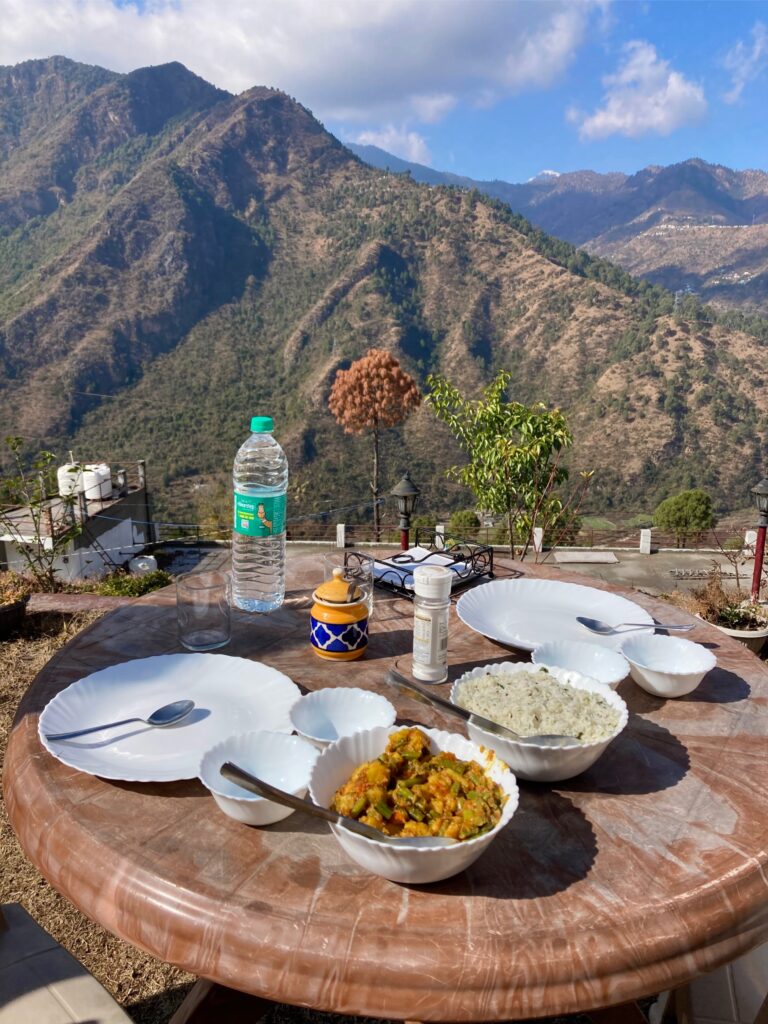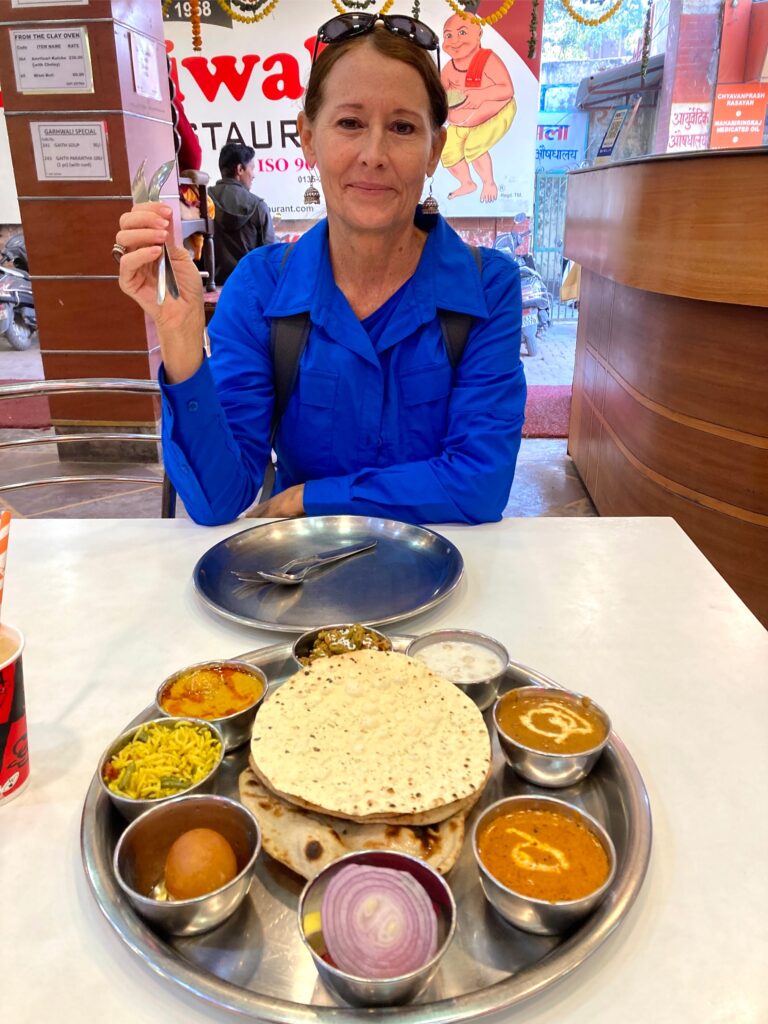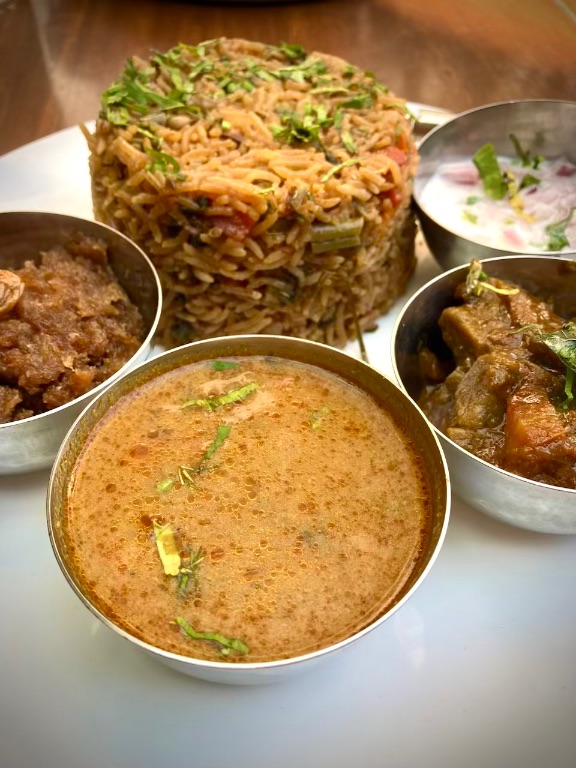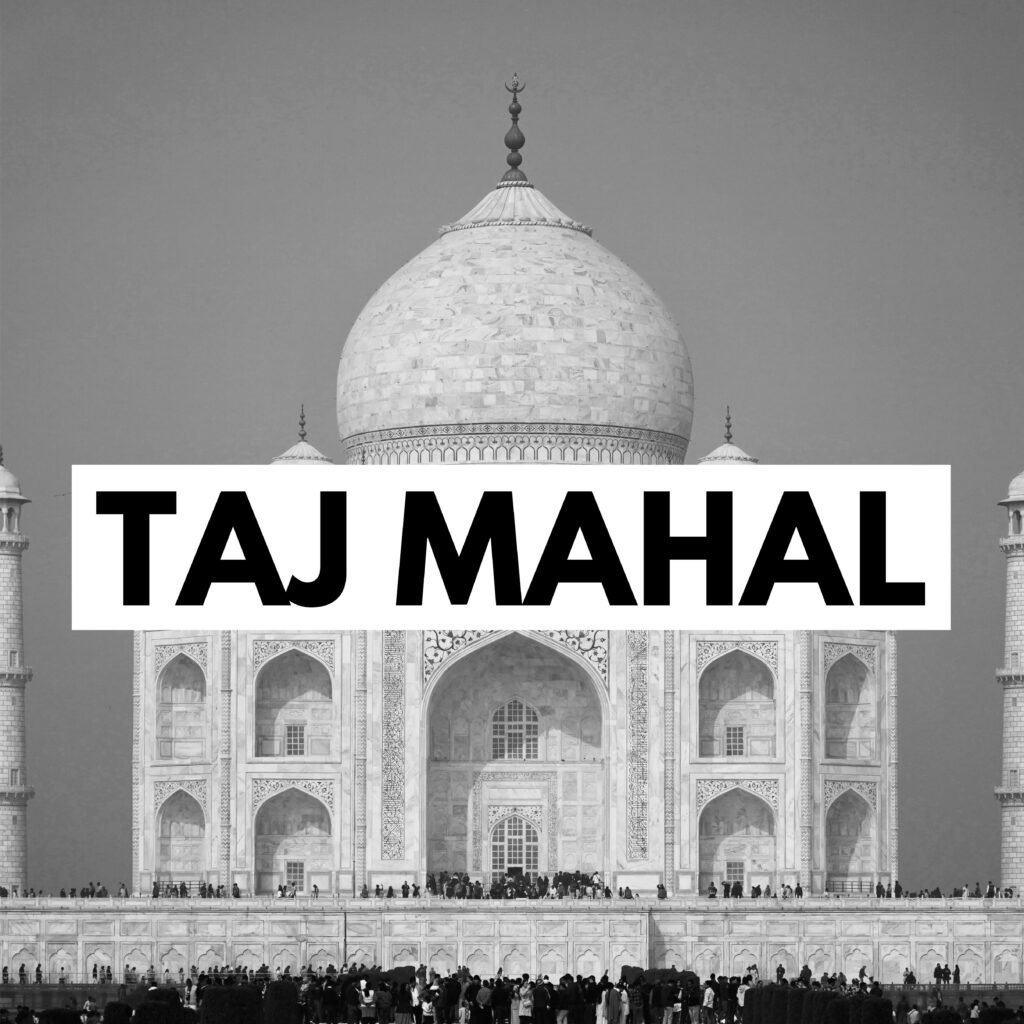We traveled by car from Delhi to Rishikesh. It’s only around 200 kilometers, or 125 miles, but it took about four hours. It takes over an hour just to get out of Delhi. As always, the ride itself is so interesting. The things you can see along the road! I observed many families and people on a pilgrimage to Rishikesh. We saw them in caravans of cars, or in wagons going down the side of the road, and some just walking, all displaying the triangle orange flag and heavily decorated with flowers. I am used to seeing many people on a motorbike, sometimes up to a family of five, but I had never seen one fall off until now.

Our car was speeding down the highway and a motorbike with a family of five passed us, then they hit a bump. A boy that looked to be around 9 or 10 fell off the back of the bike and bounced on his bottom on the highway. He immediately jumped up and ran across our lane in front of us to the median. Our driver slammed on the brakes. By this time the man driving the motorbike had pulled over and a woman had run across to the median. The boy was standing as she wrapped her arms around him, he wasn’t crying but he looked pretty shaken up. This was so scary to me, I can’t imagine how scared he must have been.


Rishikesh is not only a holy city where many people make a pilgrimage to, it’s also the international home of yoga, and one of the first things you notice is how many yoga schools there are here. Many people come here not only to earn their yoga teacher certification, but also to study Ayurvedic medicine, Reiki, Meditation, Sound Therapy, and Chakras. You will see Yogis, Sadhus, Hindu Priests, Gurus, Swamis, Buddhist Monks and Nuns, and a wide variety of people that live on the fringe walking the streets here. We spent our first two weeks in Rishikesh at The Hotel Moksham in the Tapovan neighborhood, which is located at the top of a steep hill. Which you get used to after a few days. Rishikesh is so much more laid back than Delhi, it was a relief to be here. Our hotel was great, the staff was wonderful and they also had a really good restaurant. Unfortunately, the same cold spell that was hitting Delhi was also hitting this area and our hotel was cold! Heaters are not installed in hotel rooms here as they are normally not needed. They gave us extra blankets for our bed and we called it good, but we remained cold our entire stay here, except for the very last day when a warm front came through. The owner of the hotel gave us some really good advice. He said “Don’t make a plan, just see where Rishikesh takes you and go with it.” That is exactly what we did.


Cows are considered Holy in India and they go pretty much anywhere they want to. There were cows wandering around the crowded streets of Delhi, but not overly many. This was made up for in Rishikesh. There were so many cows here. They definitely make traffic slow down. I actually loved seeing the cows. They are very well cared for here, as they are considered Holy and this is a Holy city. Food waste is separated from other garbage at every home and business. Buckets and troughs of food are put out for the cows, along with water. Cows also know where fresh grasses are left out for them and what vegetable and fruit stands they can get a hand out from. For the most part they are pretty sweet and used to being petted. I loved petting them anyway. Aaron had a run in with one of the biggest Brahma bulls either one of us has ever seen. We had seen this big boy on our street before, and had even commented on his size. Then one night as we were walking back from dinner, we ran right into him. There was a lot of traffic and noise that particular evening and as we were walking by him, he lunged at Aaron, horns down. This not only scared the crap out of us, but all the people around us moved well out of the way very quickly. We kept a wide berth around the bulls after that.

One of the first things we did after arriving was to hike down and see the Ganges River, the mother of rivers here in India. It is considered a holy river, and Rishikesh is considered a holy city. I have seen videos of the Ganges at the holy city of Varanasi (where many cremations take place) and the water looked like brown gray soup, but people on holy pilgrimages bathe in it. The river is much different here, I was so happy to be met with beautiful turquoise green water at the Ganges here in Rishikesh. This is actually the first city the river flows through as it makes its way down from the Himalayas. It’s clean, clear, and beautiful. As we walked along the very wide banks of the river, we saw many men stripping down to their underwear and dipping themselves in the holy waters. Ladies either take some water home in a container, get in fully clothed, or they do have bathing areas for women at some of the temples. The ladies here stay covered up, the men and boys don’t care. After walking some distance along the river banks we came upon a nice, small Shiva statue set among the river rocks. By the looks of it, many people leave offerings of flowers here. You will find many garlands of bright orange marigolds and smell incense burning all along the river, near temples, and entryways to buildings all over town. I think it really adds and exotic feel to the atmosphere. After being here a few days I can say that I really like the vibe of this place. Rishikesh itself is a VIBE, and you can quickly fall into a groove here.



The river splits the city into two sections. One morning we were going to cross one of the iconic suspension bridges here to the other side of Rishikesh and check it out. We found the old Laxman Jhula bridge shut down and a new one under construction. After 94 years of service it was found to have structural damage. Originally built in 1889 by Rai Bahadur, the bridge had to be rebuilt in 1924 due to severe flooding. When the wealthy Rai Bahadur had the bridge built, he had a stipulation written into law that stated the bridge, and any replacement of it would never be able to charge a toll. It was to remain free for all people to use, and it remains that way today.

Since this bridge that connected two parts of the city is closed, we decided to take the ferry boat across. There is another suspension bridge, but it is quite a ways from here. For .55 cents we took the motorboat, but had to wait for 45 minutes for it to completely fill up. That was fine, chillin’ by the riverside on a nice morning fit right into my schedule. It was one of those things you just have to go with. I found this section of Rishikesh across the river to be smaller. As far as we walked, it was made up mostly of ashrams, temples, hotels, souvenir shops, and some restaurants. While walking down the main street we decided to stop at a lemon soda cart. These vendors have very unique shaped glass bottles into which they add fresh squeezed lemon, sugar, and carbonated water. They put a marble into the bottom of the bottle and as the carbonation builds up, it pushes the marble to the top of the bottle and seals it for safe keeping. It was interesting to see how he opened the bottle and the lemon soda was really good. It’s a treat you stop for more than once! After checking all of the area out we had a good lunch at a restaurant called “Harry”. When it was time to return back across the river, we thought we’d do a river tour, having seen these small speed boats going up and down the river. But, the guy at the ticket booth either couldn’t understand what we wanted or just didn’t want to sell us the tickets. A young couple standing behind us, that spoke excellent English, asked us to ride in a private boat with them, so at least we didn’t have to wait for the ferry boat to fill up again. They were very kind and we had a nice conversation.

After wandering the narrow streets and alleyways of RIshikesh for a couple of weeks, we rented a cabin in the mountains called Chamba Nest, about an hour out of town. Here we celebrated Aaron’s birthday and our 20th wedding anniversary.

It was in a beautiful location and came with a caretaker and a cook. It was still cold, but they provided an electric heater for our little cabin. We were able to get out and do some hiking and we had great food that we could order from a menu. The cook, Rajendra, was amazing! I had not told the host about Aaron’s birthday, but I guess they noticed it while taking copies of our passports. At dinner time on his birthday, we went into the dining room and they had a table all decorated and a birthday cake, with candles, for him. We were both so shocked! It was so wonderful of them to do that, unasked! We really appreciated it. I had told the host about our anniversary and had asked for a cake to be provided.


A few days later on the big day, we went down for dinner and they had the dining room dimly lit and all decorated with candles and beautiful lamps. The caretaker, Vinod, had made a hand printed “Happy Anniversary” poster and hung it on the wall. There was a fancy cake and many little tea lites scattered around the table. They made it very romantic! Of course we shared the cakes with them. Their little bit of English was much better than our zero knowledge of Hindi, but we seemed to understand each other perfectly. They made our stay here very special.
Upon returning to Rishikesh we settled into a nice Airbnb apartment called Yogvan Holiday Apartments. We loved everything about it, except again, it was located at the top of a steep hill. After 4 or 5 days this hill got easier, so I guess it helped me with some cardio. Being on the 4th floor, I was glad it had an elevator. It seems like so many places that we stay, we have to climb multiple floors of stairs, or walk up a big hill. I know it’s good for me, I think I must be getting lazy. We were close to a great Yoga studio that I set out to at 6:45 am, every other morning. Through a construction zone, across a cow pasture, up a hill, and there I was! My guru’s name was really long so he told me just to call him Viki. Two hours of yoga and meditation in his class really set me up to have a good day. Best of all, the classes were only $3.00 each for a two hour session.
Getting an early start one morning, we decided to hike down to the Ram Jhula Suspension Bridge. Built in 1986, the Ram Jhula iron suspension bridge is an iconic landmark here in Rishikesh. Similar to the Laxman Jhula bridge being rebuilt downstream, the Ram Jhula is much larger and longer. There is a lot more going on down by this bridge as compared to the Laxman Jhula.

We wanted to visit one of the most iconic temples and ashrams in Rishikesh called the Parmarth Niketan. Built in 1942 this ashram has 1,000 rooms that they provide for people, from all over the world, coming here either on a pilgrimage, to do yoga or earn their yoga teaching certification, meditation, reiki, acupressure, to learn Ayurvedic medicine practices, or receive ayurvedic treatments. They offer a safe, clean, spiritual atmosphere along with low priced rooms and meals. I was impressed, the buildings were simple but nice, the complex had nice gardens and large grassy areas. The temple itself is across from the ashram and has a 14 foot Shiva statue sitting in meditation over the river, as the highlight. It also had a large and impressive Hanuman statue, and a very intricate marble carving of Krishna in his chariot. After strolling through the complex, we headed back towards the bridge and decided to stop for some lunch.




We had read about a legendary place we wanted to try called Chotiwala. A Chotiwala is a Brahmin cook to wealthy or royal households. The Chotiwala mascot for the restaurant is depicted with a very large, bald man, dressed in a costume and with a painted face. He sits on a throne in front of the restaurant and you can take a selfie with him if you want, but he doesn’t talk or smile. We ordered the traditional Indian Thali set here and it was pretty good. Some street children ran into the restaurant and came to our table wanting food before they were ran out by the manager. Aaron saved some chapati bread to take out to them, but of course they were no where to be found when we left. We were out by the riverside and Aaron was taking some pictures when a pretty big, black faced Languor monkey crept up behind him and slowly pulled his bag of chapati out of his camera bag. Aaron felt it at the last second, but to late, the monkey had sat down and torn the bag open and was eating the chapati breads. Very cute, but very sneaky too!


Another morning we set out and did a major hike over to the Chaurasi Kutia Ashram, better known as The Beatles Ashram. I didn’t really know what to expect, I knew it had been abandoned for a really long time, but you still have to pay to get in and look around. I certainly was not expecting it to be such a massive complex.

During the 1960s and 70s, this was the International Academy of Meditation, a training center for the students of Maharishi Mahesh Yogi. A former physicist, Maharishi Mahesh is also the person that developed the Transcendental Meditation technique. Not associated with any religion, this meditation technique teaches you how to clear your mind and focus on whatever you need to focus on in your life. It must have worked for The Beatles because they wrote most of the songs for their White Album while they were here. This was their most productive period as songwriters. They met the Maharishi after attending a lecture he gave in London, and he invited them to the Ashram, where they spent 3 months.



Spread out on over 18.5 acres, the meditation complex contains 127 individual rooms with private bathrooms. These are very cool looking, each being built from river rock, round in shape, with the bedroom and bath on the lower level, and stairs leading to an upper level where there is a small egg shaped meditation dome, and an outdoor terrace if you wanted to meditate or just sit outside. There was also the Chaurasi Kutia itself, which is a building with 84 individual meditation caves.

Chaurasi Kutia literally means 84 domiciles or 84 caves. This is what the ashram is named after. In addition to these constructions, there are also 3 huge, three level dorm room style buildings, classrooms, libraries, kitchens, dining halls, lecture hall, study halls, laundry, vegetable and herb gardens, and even small houses for families. The Beatles stayed in a large house at the back of the property. You can roam the complex at your leisure and take in all the interesting artwork that has been done over the years, in various rooms throughout the complex. Some walls are painted with the lyrics of Beatle’s songs as well. It was a very interesting place and had the most chill vibe. We wandered around for several hours and just took it all in. There are beautifully decorated, egg shaped chambers on top of each dorm building, where you also get an amazing view of the Ganges River below and the stunning forest covered mountains behind.

We had read online that it would cost 600 rupees, or $7.25 to enter. When we arrived, the sign at the ticket booth said 1,200 rupees, or $14.50, double the price we were expecting. We were a little shocked and kind of miffed. The ticket booth agent told us that the increase had just taken place because the ashram complex is now managed by the forest department and considered part of the Rajaji Tiger Reserve. The ashram complex remains heavily fenced off from the surrounding area so you even if there were a tiger in the area, it couldn’t get into the ashram complex area. There are plans to restore parts of this heritage site and turn it into a wellness and meditation area. Currently, there is a small snack bar to get drinks and snacks inside, along with restrooms. Even though it ended up costing more to enter, it was still inexpensive. It was a really great place to visit and is definitely the best modern, abandoned complex I have ever visited.

When we first arrived in Rishikesh it was still quite chilly, or just down right cold. One sunny morning we decided to walk to Nim Beach on the Ganges River. The river beaches are very big in areas and quite popular to visit. The far end of Nim Beach is covered with large boulders and backed by forest covered hills. Also a great place to watch the cute black faced Langur monkeys. We were sitting on a boulder, soaking up the warm sun and watching the river rafters going by. It looked like great fun, but I knew that water was like ice coming straight out of the Himalayas. I stated to Aaron, “You’re not getting me in there, it’s to cold!” But after being here a few weeks the weather started to warm up drastically, and the rafting looked like such fun.

So we finally decided that we were going to do it. We were going to raft the Ganges! We have rafted in several countries with the most epic, and terrifying, being the Zambezi. At least here we wouldn’t have to worry about crocodiles if we got tossed out of the boat. Our Airbnb hosts made it super easy by arranging it for us. We were picked up at our door at 10:00 am, and brought back after we were done. Talk about service! Our first stop was at the rafting center, we had to fill out a form, and we were asked if we wanted to rent wet suits. It was so warm out that we declined. Then we were back in the truck and off to the river.

You can do river trips of various lengths and I had chosen the mid-range trip of 16 kilometers. As we were walking up to the rivers edge and our guide and driver were carrying the raft down, we plainly saw that we were putting in right below a class 5 rapid. I was actually very glad that we missed that one! We got our life jackets, and helmets on, were handed our paddles, and off we went. It was just Aaron and I and our river guide. It was great fun! There were a few rapids that made me hold my breath or squeal, but it was mostly just a fun ride down the river. Our guide tried to get us to hold onto a rope and jump in and float beside the raft. Not without a wetsuit, probably not even then for me! The river was flowing so fast that our raft trip was over before we knew it. It truly was a beautiful river trip, the water of Ganges here is so clean, clear, and beautiful.

The river valley is lined with steep rock faces, boulders, and forested hillsides. All to soon we were pulling in to Nim Beach and being loaded back into the truck and driven home. It was a terrific half day adventure, and all for only $8.00 per person! Back at our Airbnb we were looking at videos other rafters had posted to the raft companies website. There were two videos of 6 and 7 foot long King Cobras swimming beside some rafts. They are a snake that fishes. Then there was another one of a python swimming by a raft and he looked at least 10 feet long. These videos were taken right here in Rishikesh. I am so glad I did not see these videos before I went rafting! Snakes aside, I am really glad we went, it was a lot of fun. Now I can say that I have rafted the Zambezi and the Ganges! Will I get to add rafting the Nile to the list? We shall see.

Being considered a holy city, Rishikesh is also an alcohol and meat free city. Both places we stayed in Rishikesh did not allow any meat or alcohol to be brought onto the premises. On Google Maps we found two beer and wine shops outside the city limits, and a place that serves chicken. So we were vegetarians for the two months we were here. I have to say that it was not a big deal, the food in India is so delicious and they know how to make a proper vegetarian meal.


I discovered Lemon Chaap, Tandoori Momos, the most fragrant Biryani, and so much more. It really puts the vegetarian food we’ve had in all other countries to shame. We never felt like we were missing anything either.


We had a lot of wonderful seafood in Goa, and outside of that we actually didn’t eat much meat anywhere in India because the vegetarian food is so delicious. We never got the dreaded “Delhi Belly” either. I hope I am able to recreate some of these dishes myself later on down the road.
Check Out Our Guide To Rishikesh India Video


